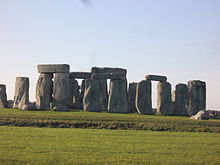 Were the Stonehenge stones chosen for their musical properties?
Were the Stonehenge stones chosen for their musical properties?
The Stonehenge bluestones were quarried and brought to Salisbury Plain from a village in Wales named Maenclochog – a name that means “bell stones” or “ringing stones.”
Now, a startling new report speculates that Stonehenge may have been a prehistoric center for ritual sounds.
Here are some of the ideas now being considered by experts from London’s Royal College of Art, as reported by Sarah Griffiths and Amanda Williams in the Daily Mail…
Stonehenge may have been built by Stone Age man as a prehistoric centre for rock music, a new study has claimed.
According to experts from London’s Royal College of Art, some of the stones sound like bells, drums, and gongs when they are ‘played’ – or hit with hammers.
Archaeologists, who have pondered why stone age man transported Bluestones 200 miles from Mynydd Y Preseli in Pembrokshire, South West Wales to Stonehenge, believe this discovery could hold the key.
The ‘sonic rocks’ could have been specifically picked because of their ‘acoustic energy’ which means they can make a variety of noises ranging from metallic to wooden sounding, in a number of notes.Research published today in the Journal of Time & Mind reveals the surprising new role for the Preseli Bluestones which make up the famous monument, and which were sourced from the Pembrokeshire landscape on and around the Carn Menyn ridge, on Mynydd Preseli, South-West Wales.
A significant percentage of the rocks on Carn Menyn produce metallic sounds – like bells, gongs or tin drums – when struck with small hammerstones. Such sonic or musical rocks are referred to as ‘ringing rocks’ or ‘lithophones’.
The Landscape & Perception project drew upon the comments of the early ‘rock gong’ pioneer, Bernard Fagg, a one-time curator of the Pitt Rivers Museum, in Oxford.
He suspected there were ringing rocks on or around Preseli and suggested that this was the reason why so many Neolithic monuments exist in the region – with the sounds making the landscape sacred to Stone Age people.